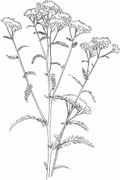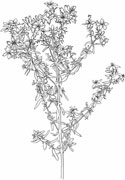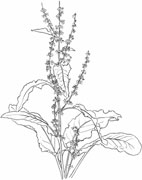Ryan Drum
Island Herbs
P O Box 25, Waldron, WA 98297-0025
About Ryan | Articles | Contact Ryan
How to prepare Dr. Drum’s All-Purpose Herbal Salve
Oct. 2010
Ingredients: Olive Oil, Cocoa Butter, Beeswax, Birch Essential Oil; Fresh Herbs: Mullein Leaf and floral buds, Plantain Leaf, Yarrow Leaves, Comfrey Leaf, Chickweed Emergent parts, St. John’s Wort unopened Floral Buds, Yellowdock Leaves, Calendula Petals; Poplar Bud Oil.
Olive Oil: I try to use Organic extra virgin olive oil. When that is not available, I use the best Olive Oil I can obtain. I recommend Olive Oil packed/stored in metal cans or glass rather than plastic containers. Oil-soluble chemicals in the plastic container may leach into the olive oil, especially endocrine-disruptive plastisizers.
Cocoa Butter: I try to use food-grade bulk Cocoa Butter for my salves. Do not use modified beauty product cocoa butter.
Beeswax: I use beeswax obtained from local beekeepers whenever possible.
Birch Essential Oil: this essential oil is added just prior to pouring the molten salve into storage, at the rate of 100mg oil per liter of salve.
Special Tools: To cut herbs finely before placing into the maceration oil, use only sharp stainless utility scissors; non-stainless steel blades will react with the cut herb surfaces, possibly negatively.
Container(s): I use wide-mouth 2-quart canning jars in which to macerate smaller batches of salve oil. They are easy to move, clean and can be heated safely in a double boiler. For larger batches, I have used 1-Gal./4-litre Screw-top glass jars.
Timing: I prefer to harvest fresh herbs for salves on cool, cloudy days during low thermal and solar stress.
Macerating All Salve Herbs Together: A better all-purpose salve results from macerating the herbs together. This means harvesting them on the same day and macerating all together in the same container of macerating oil. (With the noted exceptions of Comfrey Root Oil and Poplar Bud Oil)
Herbs: one part each of:
 Mullein
leaf and floral buds (Verbascum thapsis):
I like to use fresh first year mullein leaves harvested in Gemini. These leaves
are growing in a rosette. Pick only actively-growing leaves with no mold on
their lower surfaces. When first year leaves are not available, I will use
young second year leaves from either the basal rosette or from low on the
flowering stalk. Often, I have observed extensive underside fungal growth
on second year mullein leaves, especially on the lower portions of large flowering
stalks. 5-10 cm long young floral clusters with some opened flowers but mostly
unopened floral buds are cut from the main flowering stalk. Both leaves and
floral clusters and finely cut and placed in the oil. Together, the leaves
and floral clusters make 1 part.
Mullein
leaf and floral buds (Verbascum thapsis):
I like to use fresh first year mullein leaves harvested in Gemini. These leaves
are growing in a rosette. Pick only actively-growing leaves with no mold on
their lower surfaces. When first year leaves are not available, I will use
young second year leaves from either the basal rosette or from low on the
flowering stalk. Often, I have observed extensive underside fungal growth
on second year mullein leaves, especially on the lower portions of large flowering
stalks. 5-10 cm long young floral clusters with some opened flowers but mostly
unopened floral buds are cut from the main flowering stalk. Both leaves and
floral clusters and finely cut and placed in the oil. Together, the leaves
and floral clusters make 1 part.
Mullein is used for its nerve-deadening component, Rotenone; this substance quells pain topically and in the ear when mullein oil drops are used.
 Plantain
Leaf (Plantago lanceolata): I use only
fresh longleaf plantain for salves (and topical spit poultices). Broadleaf
plantain has not worked well in oils or salves for me. I have not tried to
use Plantago maritimissa, but would if P.
lanceolata were not available.
Plantain
Leaf (Plantago lanceolata): I use only
fresh longleaf plantain for salves (and topical spit poultices). Broadleaf
plantain has not worked well in oils or salves for me. I have not tried to
use Plantago maritimissa, but would if P.
lanceolata were not available.
Plantain leaf is best used prior to the full growth of the flowering stalks (as taught by my teacher, Ella Birzneck). I cut the leaves below their respective attachments to the top of the basal corm, which means a bit of basal corm material is also harvested with each leaf or a cluster of leaves. The leaves are finely cut as soon as possible and placed in the macerating oil. Plantain leaves deteriorate quickly after removal from their corm.
Plantain is used for its mild analgesic property and it’s epidermal growth factor (EGF) content. When the skin is cut, epidermal growth factor is released and rushed to the wound site. EGF levels in the blood increase; consequently, EGF levels sharply rise in the saliva. This is why a spit poultice of Plantain is so effective in promoting skin wound healing and closure. All mammals lick their wounds to apply EGF to the site. In my patient observations, one’s own salivary EGF seems to work better than a strangers’.
Plantain is an essential ingredient in my all-purpose salve. Dried Plantain leaves seem almost useless in salves.
 Yarrow
leaf and flowering tops (Achillea millefolium):
fresh yarrow basal rosette leaves and middle-aged flowering tops (some florets
forming seeds, some opened and displaying beautiful golden-orange pollen on
their anthers, and some unopened floral buds) are harvested and finely cut
into the salve oil.
Yarrow
leaf and flowering tops (Achillea millefolium):
fresh yarrow basal rosette leaves and middle-aged flowering tops (some florets
forming seeds, some opened and displaying beautiful golden-orange pollen on
their anthers, and some unopened floral buds) are harvested and finely cut
into the salve oil.
Yarrow in harsh dry conditions often seems to contain more aromatics and secondary metabolites (old plant physiology maxim: less water, more differentiation). I have observed the same in seaside yarrow, which I prefer for salves and oils. A yarrow spit poultice is an exceptionally effective topical analgesic for insect stings and bites. In salves, yarrow improves subdermal circulation by opening the distal arterioles, and lessens pain, and seems to promote vascular repair.
 Chickweed
emergent parts (Stellaria media): vibrant
bright green fresh leaves, stems, flowers of chickweed are quickly cut and
placed in the oil . Keep chickweed old dead leaves and brown stems out of
the salve oil.
Chickweed
emergent parts (Stellaria media): vibrant
bright green fresh leaves, stems, flowers of chickweed are quickly cut and
placed in the oil . Keep chickweed old dead leaves and brown stems out of
the salve oil.
Old gardens and greenhouses are good sources of fresh chickweed. Jethro Kloss in "Back to Eden" recommended tearing out the rest of the garden and leaving the chickweed as the only green vegetable. Chickweed is a delicious salad green alone or in the mix. It is especially thirst-quenching in the heat of summer.
I am not certain of the specific contribution of Chickweed to salves, but it does add something important. I use freshly squeezed out chickweed juice directly into or onto the surfaces of irritated eyes, including those suffering from “pinkeye”. The effect is an often miraculously calming.
 Comfrey
leaf and/or root (Symphytum spp.): fresh
green comfrey basal rosette leaves are cut finely into the salve oil soon
after picking. They are extremely watery and that contained water may be difficult
to eliminate from the salve oil and hence promote subsequent water-driven
moulds in the final product(s).
Comfrey
leaf and/or root (Symphytum spp.): fresh
green comfrey basal rosette leaves are cut finely into the salve oil soon
after picking. They are extremely watery and that contained water may be difficult
to eliminate from the salve oil and hence promote subsequent water-driven
moulds in the final product(s).
To prevent this, comfrey roots are cut finely and dried to a hard crack on screens at 80-90oF and then ground to a fine powder. The powder is oil infused 3:1, oil to comfrey powder, at 80-90oF for a week or more, with stirring at least twice daily to resuspend the comfrey powder in the hot oil.
Let the oil and powder set for 24-48 hours at room temperature and carefully pour off only the oil into the macerating salve oil with herbs therein; then stir very well several times during the subsequent 48 hours to thoroughly mix the comfrey root oil with the rest of the salve oil.
I tried several times to get my sons to eat the comfrey powder remaining after the infused oil had been decanted, by mixing the comfrey powder with fine olive oil to make comfrey root powder “butter”. They did not care for it. The mouth feel was…”weird, Dad.”
 St.
John’s Wort unopened floral buds (Hypericum perfoliatum):
the unopened floral buds of Hypericum will exude bright purple-red juice when
squished. Even just-opened floral buds, as well as maturing blossoms, do not
display this red juice when smooshed. Some tidy research demonstrated that
the active compound in Hypericum is destroyed when the blossoms are cut or
squished. So, I do not cut the St. John’s Wort floral buds prior to
putting them into the salve oil.
St.
John’s Wort unopened floral buds (Hypericum perfoliatum):
the unopened floral buds of Hypericum will exude bright purple-red juice when
squished. Even just-opened floral buds, as well as maturing blossoms, do not
display this red juice when smooshed. Some tidy research demonstrated that
the active compound in Hypericum is destroyed when the blossoms are cut or
squished. So, I do not cut the St. John’s Wort floral buds prior to
putting them into the salve oil.
 Yellow
dock Leaves (Rumex crispus): are sometimes
picked and cut from their annual basal cluster and added to the salve oil.
Yellow
dock Leaves (Rumex crispus): are sometimes
picked and cut from their annual basal cluster and added to the salve oil.
 Calendula (spp.): bright orange petals
are also added to the salve oil when available.
Calendula (spp.): bright orange petals
are also added to the salve oil when available.
The oil:herbs ratio is 3:1. That means 3 pounds of oil to 1 pound of wet herbs. I usually have the empty jar on the scale whilst I add the herbs slowly to a pound, and then top up with oil in the 2-Quart jars. The jar is loosely covered and placed on a dedicated salve making shelf immediately above my wood heater where it remains up to 29 days (a Lunar month), being stirred thoroughly at least twice a day. My herb teacher, Ella Birzneck, tried to make her salves in the summer and set them in full sun everyday to get the sun’s other energy in addition to heat.
 Poplar
Bud Oil (Populus spp.): Poplar bud oil
is made during the months Nov-Mar using extremely resinous unopened dormant
Poplar buds. I use fresh buds picked from winter windfall branches of the
Huge Pacific Northwest Balm of Gilead Poplar (Black Cottonwood, Populus trichocarpa).
I try to pick on 35-45oF cool dry days when the
resins are brittle rather than sticky. Buds so picked can be stored cold for
a few days prior to placing into 3:1 olive oil and left there for up to 3
years or until used. The first few weeks the poplar buds are in their macerating
oil, their container is placed on the salve shelf above the heater and may
warm to 100oF on some days. They are shaken and/or
stirred as often as noticed. The resulting oil will usually be very orangish
and thick, with a wonderful aroma.
Poplar
Bud Oil (Populus spp.): Poplar bud oil
is made during the months Nov-Mar using extremely resinous unopened dormant
Poplar buds. I use fresh buds picked from winter windfall branches of the
Huge Pacific Northwest Balm of Gilead Poplar (Black Cottonwood, Populus trichocarpa).
I try to pick on 35-45oF cool dry days when the
resins are brittle rather than sticky. Buds so picked can be stored cold for
a few days prior to placing into 3:1 olive oil and left there for up to 3
years or until used. The first few weeks the poplar buds are in their macerating
oil, their container is placed on the salve shelf above the heater and may
warm to 100oF on some days. They are shaken and/or
stirred as often as noticed. The resulting oil will usually be very orangish
and thick, with a wonderful aroma.
After the main salve oil has been decanted several times, with no obvious minute dark water droplets settling to the bottom of the final receiving jar, several ounces (imprecise) of the Poplar bud oil is added to each batch of salve oil.
CAUTION: Do not press or squeeze the oil-infused plant mass in an attempt to recover more infused oil. Usually, there are tiny cryptic water droplets in the infused herb mass which will remain in the infused herb mass if the infused oil is just poured off slowly (decanted). Water in the salve oil or salves will tend to promote bacterial and fungal growth to the detriment of the salves.
The benzoic portion of the Populin in the Poplar bud oil acts as a strong antioxident and keeps the final salve oil and salves from becoming rancid as well as imparting a fine aroma. By itself, Poplar bud oil is an excellent topical for relief of chronic joint and muscle pain; when mixed 1:1 with St. John’s Wort oil, the two together make a very effective topical for fresh burns.
Final steps to herbal salve: the decanted salve oil with the Poplar bud oil having been added, is heated in a double water boiler until shaved beeswax melts readily and then enough beeswax (about 20% by volume) is added with a few ounces of premium cocoa butter.
To test the salve oil for desired consistency after cooling, tiptake a drop and place on a cold surface. When the consistency seems okay, stir in the Birch oil quickly and pour resulting mixture into the desired containers.
NOTE: Salve oil will remain stable as an oil for several months after the addition of the Poplar bud oil.
VARICOSE VEIN OIL/SALVE
A long-term use topical oil for varicose veins is made from equal parts of Yarrow oil and Dalmatian Toadflax (Linium Dalmatica) oil. The oils are made separately and then combined in equal amounts.
On the recommendation of my teacher, Ella Birzneck, entire live yarrow stalks with open flowering tops as well as the basal rosette leaves are cut finely and placed in maceration oil with a 1:3 ratio of Yarrow to oil, and infused at 80-90oF for a week or more, with regular stirring each day. Decant settled oil at least twice before mixing.
Settle, and decant oil only; do not squeeze out oil. To do so will tend to squeeze out tiny water droplets into the infused and decanted oil. Store in cool dark place until mixed with infused Toadflax oil: toadflax infused olive oil is made by collecting toadflax leaves and flowering stalks w/ whole flower buds on, cutting finely, and placing in the macerating oil, stirred well and placed in a canning jar on the salve shelf for two weeks. The oil is then decanted and usually mixed in equal amounts with the Yarrow oil, stirred well and stored for use as needed.
This salve is especially useful for resolving/removing solid perianal lumps.
BENIGN LUMP SALVE
A topical salve for resolving benign external lumps can be prepared from equal amounts of separately infused fresh, live fig leaf and fruit bud (Ficus carica) infused oil with Greater Celandine (Chelidonium majus) fresh roots, finely chopped, and infused in olive oil.
The separate oils are prepared by infusing in olive oil in a 3:1 ratio of oil to plant material. Macerate each in a separate 1-quart canning jar for at least two weeks each, on the salve shelf, at 80-90oF. Stir frequently. Decant several times, pouring off only the infused oil, as above. Store the oil separately until needed; then, mix and let stand for 12-24 hours prior to mixing and preparing salve from the two mixed infused oils.
The fig oil was used because of the known flesh-dissolving properties of fig latex, which contains phenol.
The greater celandine oil was used for its known property of disrupting cell replication by scattering the mitotic spindle and dissembling the spindle microtubules.
About Ryan | Articles | Contact Ryan
©2005-2021 Ryan Drum
P O Box 25, Waldron, WA 98297-0025
Updated 04-10-2021
Website by
